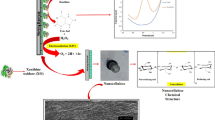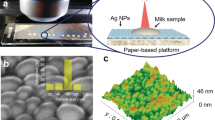Abstract
The objective of this study was to develop nanofibrillated cellulose (NFC)-based substrate for rapid detection of melamine in milk by surface-enhanced Raman spectroscopy (SERS). NFC were served as a highly porous platform to load with gold nanoparticles (AuNPs), which can be used as a flexible SERS substrate with nanoscale roughness to generate strong electromagnetic field in SERS measurement. The NFC/AuNP substrate was characterized by UV–Vis spectroscopy and electron microscopy. Milk samples contaminated by different concentrations of melamine were measured by SERS coupled with NFC/AuNP substrate. The spectral data analysis was conducted by multivariate statistical analysis [i.e. partial least squares (PLS)]. Satisfactory PLS result for quantification of melamine in milk was obtained (R = 0.9464). The detection limit for melamine extracted from liquid milk by SERS is 1 ppm, which meets the World Health Organization’s requirement of melamine in liquid milk. These results demonstrate that NFC/AuNP substrate has improved homogeneity and can be used in SERS analysis for food safety applications.







Similar content being viewed by others
References
Abdul Khalil HPS, Davoudpour Y, Islam MN, Mustapha A, Sudesh K, Dungani R, Jawaid M (2014) Production and modification of nanofibrillated cellulose using various mechanical processes: a review. Carbohydr Polym 99:649–665
Ballerini DR, Ngo YH, Garnier G, Ladewig BP, Shen W, Jarujamrus P (2014) Gold nanoparticle-functionalized thread as a substrate for SERS study of analytes both bound and unbound to gold. AIChE J 60:1598–1605
Brown CA et al (2007) Outbreaks of renal failure associated with melamine and cyanuric acid in dogs and cats in 2004 and 2007. J Vet Diagn Invest 19:525–531
Creighton JA, Eadon DG (1991) Ultraviolet–visible absorption spectra of the colloidal metallic elements. J Chem Soc, Faraday Trans 87:3881–3891
Dorne JL et al (2013) Recent advances in the risk assessment of melamine and cyanuric acid in animal feed. Toxicol Appl Pharmacol 270:218–229
Doyen M, Bartik K, Bruylants G (2013) UV–Vis and NMR study of the formation of gold nanoparticles by citrate reduction: observation of gold–citrate aggregates. J Colloid Interface Sci 399:1–5
Fan M, Andrade GF, Brolo AG (2011) A review on the fabrication of substrates for surface enhanced Raman spectroscopy and their applications in analytical chemistry. Anal Chim Acta 693:7–25
Filazi A, Sireli U, Ekici H, Can H, Karagoz A (2012) Determination of melamine in milk and dairy products by high performance liquid chromatography. J Dairy Sci 95:602–608
Frens G (1973) Controlled nucleation for the regulation of the particle size in monodisperse gold suspensions. Nature 241:20–22
Giovannozzi AM, Rolle F, Sega M, Abete MC, Marchis D, Rossi AM (2014) Rapid and sensitive detection of melamine in milk with gold nanoparticles by surface enhanced Raman scattering. Food Chem 159:250–256
Gong Z, Du H, Cheng F, Wang C, Wang C, Fan M (2014) Fabrication of SERS swab for direct detection of trace explosives in fingerprints. ACS Appl Mater Interfaces 6:21931–21937
Hsieh T-J, Hsieh P-C, Tsai Y-H, Wu C-F, Liu C-C, Lin M-Y, Wu M-T (2012) Melamine induces human renal proximal tubular cell injury via transforming growth factor-beta and oxidative stress. Toxicol Sci 130:17–32
Klemm D, Kramer F, Moritz S, Lindström T, Ankerfors M, Gray D, Dorris A (2011) Nanocelluloses: a new family of nature-based materials. Angew Chem Int Ed Engl 50:5438–5466
Koglin E, Kip BJ, Meier RJ (1996) Adsorption and displacement of melamine at the Ag/electrolyte interface probed by surface-enhanced Raman microprobe spectroscopy. J Phys Chem C 100:5078–5089
Kong X-M, Reza M, Ma Y-B, Hinestroza J-P, Ahvenniemi E, Vuorinen T (2015) Assembly of metal nanoparticles on regenerated fibers from wood sawdust and de-inked pulp: flexible substrates for surface enhanced Raman scattering (SERS) applications. Cellulose 22:3645–3655
Kumar S, Gandhi K, Kumar R (2007) Modeling of formation of gold nanoparticles by citrate method. Ind Eng Chem Res 46:3128–3136
Lee NS, Hsieh YZ, Paisley RF, Morris MD (1988) Surface-enhanced Raman spectroscopy of the catecholamine neurotransmitters and related compounds. Anal Chem 60:442–446
Li L, Li B, Cheng D, Mao L (2010) Visual detection of melamine in raw milk using gold nanoparticles as colorimetric probe. Food Chem 122:895–900
Marques PA, Nogueira HI, Pinto RJ, Neto CP, Trindade T (2008) Silver-bacterial cellulosic sponges as active SERS substrates. J Raman Spectrosc 39:439–443
Moskovits M (2005) Surface-enhanced Raman spectroscopy: a brief retrospective. J Raman Spectrosc 36:485–496
Ngo YH, Li D, Simon GP, Garnier G (2012) Gold nanoparticle–paper as a three-dimensional surface enhanced raman scattering substrate. Langmuir 28:8782–8790
Organization WH (2010) International experts limit melamine levels in food. http://www.who.int/mediacentre/news/releases/2010/melamine_food_20100706/en/. Accessed 1 Mar 2017
Polavarapu L, Porta AL, Novikov SM, Coronado-Puchau M, Liz-Marzán LM (2014) Pen-on-paper approach toward the design of universal surface enhanced Raman scattering substrates. Small 10:3065–3071
Polte Jr, Ahner TT, Delissen F, Sokolov S, Emmerling F, Thünemann AF, Kraehnert R (2010) Mechanism of gold nanoparticle formation in the classical citrate synthesis method derived from coupled in situ XANES and SAXS evaluation. J Am Chem Soc 132:1296–1301
Rovina K, Siddiquee S (2015) A review of recent advances in melamine detection techniques. J Food Compost Anal 43:25–38
Smith E, Dent G (2013) Modern Raman spectroscopy: a practical approach. Wiley, Hoboken
Smoker M, Krynitsky AJ (2008) Interim method for determination of melamine and cyanuric acid residues in foods using LC-MS/MS: version 1.0. http://www.chemicalresearch2000.it/melaminecyanuricacfoodlcmsms_fda_lib4422.pdf. Accessed 1 Feb 2017
Sugita T, Ishiwata H, Yoshihira K (1990) Release of formaldehyde and melamine from tableware made of melamine—formaldehyde resin. Food Addit Contam 7:21–27
Tian Z-Q, Ren B, Wu D-Y (2002) Surface-enhanced Raman scattering: from noble to transition metals and from rough surfaces to ordered nanostructures. J Phys Chem B 106:9463–9483
Wei H, Rodriguez K, Renneckar S, Leng W, Vikesland PJ (2015) Preparation and evaluation of nanocellulose–gold nanoparticle nanocomposites for SERS applications. Analyst 140:5640–5649
Zhang L et al (2015a) Cellulose nanofibre textured SERS substrate. Colloids Surf A 468:309–314
Zhang Z, Yu Q, Li H, Mustapha A, Lin M (2015b) Standing gold nanorod arrays as reproducible SERS substrates for measurement of pesticides in apple juice and vegetables. J Food Sci 80:N450–N458
Zimmermann T, Bordeanu N, Strub E (2010) Properties of nanofibrillated cellulose from different raw materials and its reinforcement potential. Carbohydr Polym 79:1086–1093
Acknowledgments
This study was partially supported by USDA NIFA Multi-State Project (NC1194) and Nanotechnology Program (2016-67021-24994).
Author information
Authors and Affiliations
Corresponding author
Electronic supplementary material
Below is the link to the electronic supplementary material.
Rights and permissions
About this article
Cite this article
Xiong, Z., Chen, X., Liou, P. et al. Development of nanofibrillated cellulose coated with gold nanoparticles for measurement of melamine by SERS. Cellulose 24, 2801–2811 (2017). https://doi.org/10.1007/s10570-017-1297-7
Received:
Accepted:
Published:
Issue Date:
DOI: https://doi.org/10.1007/s10570-017-1297-7




